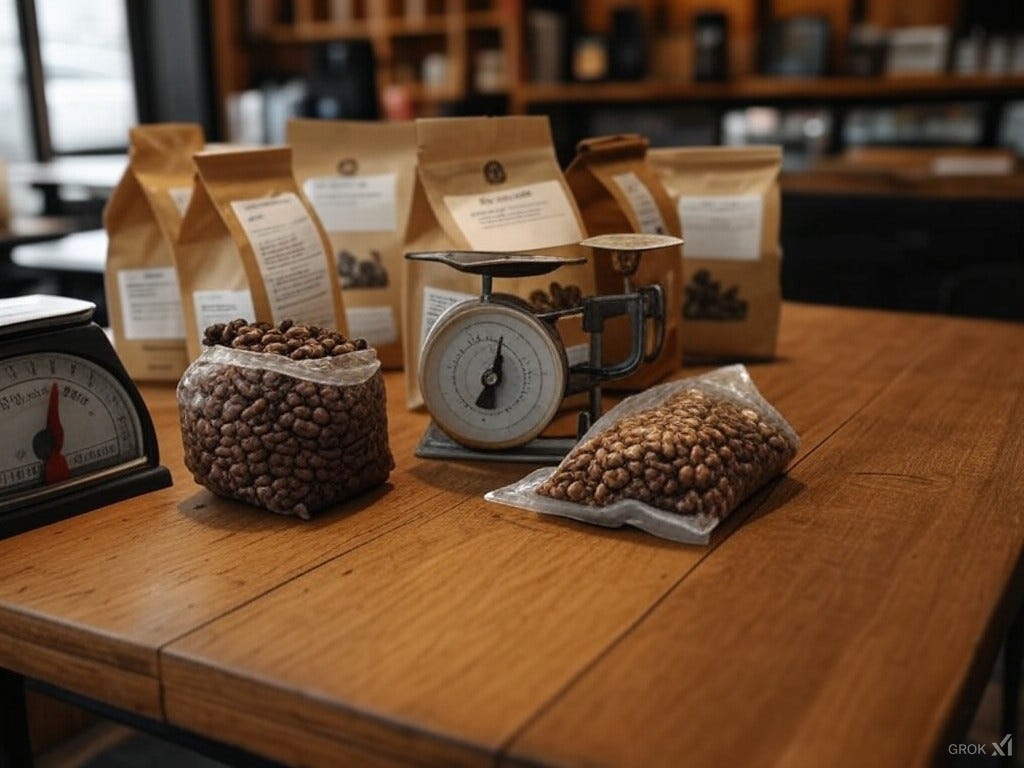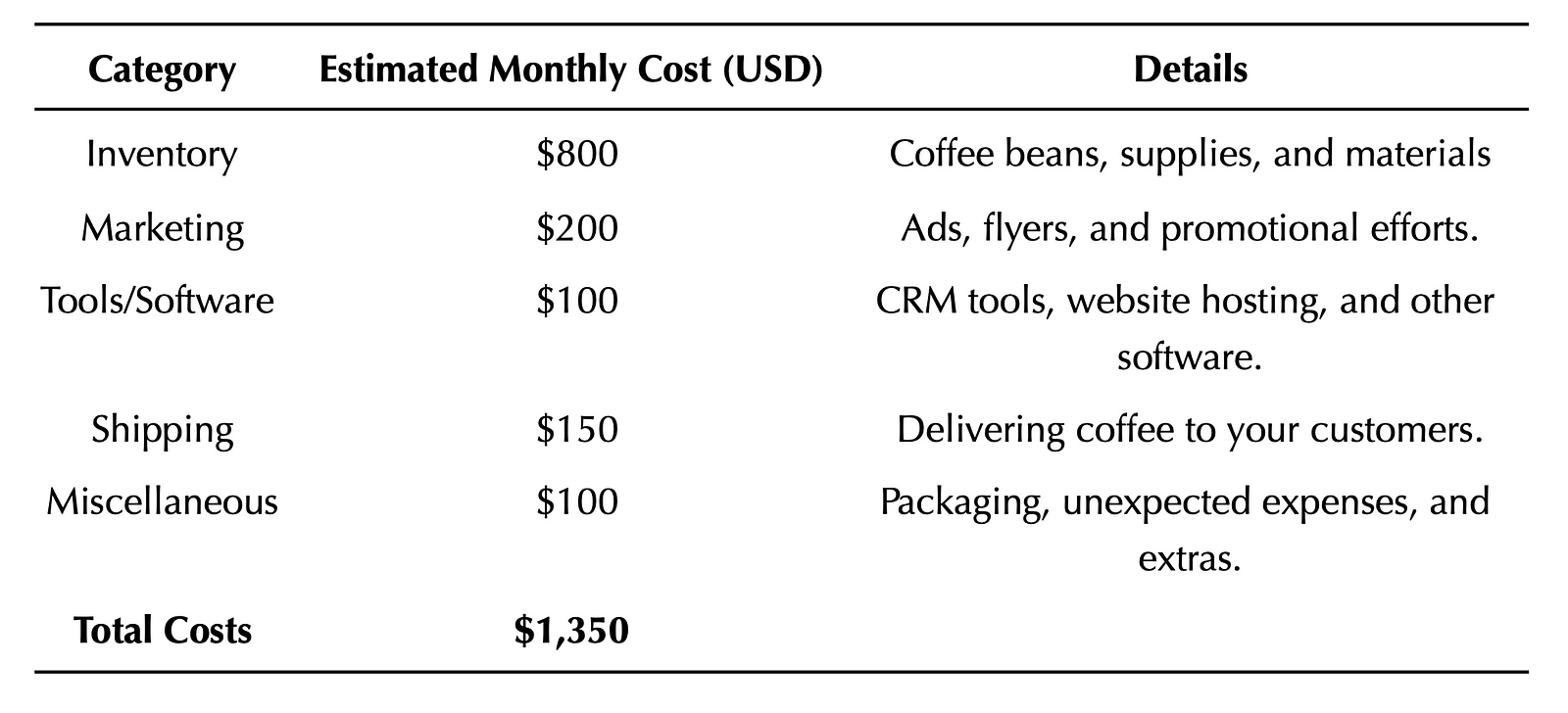How to Build Your Coffee Brand on the Side
Transform Your Love for Coffee into Revenue

Transform Your Love for Coffee into Revenue
Imagine waking up each morning knowing you’re running a successful coffee business that local businesses love. You’re not just serving great coffee; you’re building strong relationships and enjoying the sweet taste of profits.
Starting might feel overwhelming. Your 9-to-5 job takes up most of your time, and balancing family and personal life seems tricky. But during weekends, you dive into market research, discovering which local businesses crave quality coffee. Maybe you find that nearby offices need a reliable supplier or that coffee shops are searching for unique blends to wow their customers.
You begin by listing potential clients and reaching out to them one by one. Maybe you send a friendly email or have a chat during your lunch break. You learn what they love about their current coffee and what they wish was different. This small effort can lead to big opportunities.
Next, you source the best beans. Perhaps you team up with a local roaster who shares your passion for quality. You create different blends to cater to various tastes, making your offerings stand out.
As you develop your product, you prepare a sample package. Imagine sending it out and getting that first exciting response — a business wants to try your coffee. Your heart races as your first sale comes through, and suddenly, your dream feels real.
Building your sales and marketing strategy is like crafting your story. You create a simple website showcasing your coffee and reach out through emails or networking events. Offering free samples or trial periods can turn curious businesses into loyal customers.
Each small win fuels your motivation.
Balancing work and your side hustle won’t be easy, but every step you take brings you closer to your dream. From brainstorming ideas late at night to celebrating your first sale, you’re building something amazing.
The Market Potential
Starting a side business selling coffee to local companies is a great idea, especially for busy professionals like you. Picture being the go-to coffee supplier for offices, cafes, and shops in your area. These businesses need high-quality coffee to keep their customers and employees satisfied.
With everyone juggling work and life, having a reliable coffee supplier becomes more convenient than ever. You’ve got the skills from your day job, and now you can use your evenings and weekends to build something special. Picture yourself connecting with other local businesses, understanding their needs, and providing them with the perfect coffee blends they crave.
Market Analysis & Opportunities
The coffee market is booming! According to recent studies, the demand for high-quality coffee has grown by 8% over the last two years. Local businesses, from cozy cafes to bustling offices, are always on the lookout for new and reliable coffee suppliers. While there are big players in the market, many businesses still seek personal relationships and unique offerings that larger companies can’t provide.
One significant opportunity lies in partnering with local coffee shops. They often need diverse coffee blends to stand out and keep their customers coming back. Another gap you can fill is supplying offices with consistent, quality coffee that keeps their teams energized. Plus, there’s a rising trend of businesses wanting to support local suppliers, which means more chances for you to create lasting partnerships.

Unexplored niches are also waiting for you. Offering specialty blends or organic coffee can attract health-conscious businesses. Additionally, providing flexible delivery options and bulk discounts can make your service irresistible to busy entrepreneurs looking for convenience and value.
Conclusion
You’ve got everything it takes to tap into this growing coffee market. Even with a full-time job, dedicating a few hours each week can set you on the path to success. The demand is there, the opportunities are ripe, and your passion for coffee can make a real difference in your community.
Ready to take the first step? Let’s explore the key steps to starting your coffee-selling journey and turning your dream into a thriving side business!
Step-by-Step Guide
Step 1: Market Research (Weeks 1–4)
- Identify Potential Clients: Think about coffee shops, offices, and restaurants in your area. Use online directories or local business associations. Jot down names during your lunch breaks or while commuting.
- Research Their Coffee Needs: What brands do they currently use? What do they love or dislike about their current suppliers? A quick survey or casual conversation can yield valuable insights.
- Resources: Utilize local business directories and online survey platforms like SurveyMonkey. A simple CRM tool can help you track your findings.
Step 2: Develop Product Offerings (Weeks 5–8)
- Source High-Quality Beans: Connect with local roasters or suppliers who share your passion for quality. Visit them on weekends or after work to discuss options.
- Create a Competitive Pricing Structure: To attract larger orders, consider offering bulk discount pricing in small increments.
- Prepare Sample Packages: These packages showcase your coffee and include details about your sourcing and roasting process. This can be a fun project to work on during a quiet evening at home.
- Resources: Look for local coffee roasters and wholesale suppliers. Pricing guides can help you set competitive rates.
Step 3: Sales and Marketing Strategy (Weeks 9–12)
- Develop a Targeted Sales Strategy: Use your evenings to draft emails or make calls to potential clients. Networking events can be a great way to meet local business owners.
- Create a Professional Website: Platforms like Wix or Shopify make it easy to set up an online presence in just a few hours.
- Offer Free Samples: Entice businesses with free samples to start conversations and lead to your first orders.
- Resources: CRM software is used to manage client relationships and email marketing platforms like Mailchimp for outreach.
Step 4: Building Relationships (Weeks 13–16)
- Follow Up with Potential Clients: A friendly reminder or a quick check-in can keep you on top of mind.
- Attend Local Business Events or Coffee Meetups: These gatherings are a goldmine for networking and building relationships.
- Resources: Local business associations often host events. Websites like Meetup can help you find relevant gatherings.
Step 5: Launching Your Business (Weeks 17–20)
- Finalize Product Offerings and Pricing: Ensure everything is in place for your first orders.
- Reach Out to Identified Clients: Begin placing orders and see your hard work pay off!
- Monitor Sales and Gather Feedback: Refine your offerings based on client feedback.
- Resources: Use a simple spreadsheet to track orders and client feedback.
Tools and Resources
- CRM Software: Tools like HubSpot or Salesforce help manage client relationships and sales processes, saving you time and effort.
- Email Marketing Platforms: Mailchimp or Constant Contact make it easy to reach potential clients with targeted messages.
- Website Development Tools: Use Shopify or Wix to create a professional online presence without needing extensive tech skills.
Common Pitfalls
- Overlooking Market Research: Many new entrepreneurs skip this step, thinking they know their market. Don’t fall into this trap! Take the time to understand your potential clients’ needs.
- Neglecting Relationships: It is crucial to build connections with local businesses. A personal touch can set you apart from larger suppliers.
- Ignoring Feedback: Once you start selling, listen to your clients. Their feedback can help you improve and grow your business.
Conclusion
If you have the passion and the plan to make your coffee-selling dream a reality, go for it. Starting this side business may seem daunting, but remember, every small step counts. Dedicate a few hours each week, and soon you’ll be on your way to becoming a local coffee supplier.
Are you ready to explore this further? Let’s explore the skills and resources needed to make this journey even more successful!
Equipping Yourself for Success
Imagine setting out on a journey without a map — scary, right? Starting your coffee-selling side business is just like that journey. Preparation is your map, guiding you toward your dream. By getting ready, you’re increasing your chances of success and building the confidence to turn your vision into reality. Let’s explore the essential skills, tools, and resources that will help you navigate this exciting venture.
Skills Needed
Starting and managing your coffee business isn’t just about loving coffee — though that’s a big part of it!
Here are the key skills you’ll need:
- Marketing: It's vital to know how to promote your coffee. Whether through social media, email campaigns, or word-of-mouth, effective marketing helps you reach the right customers. Think of it as telling your coffee’s story in a way that makes people excited to try it.
- Customer Service: Building strong relationships with your clients keeps them coming back. Good customer service means listening to their needs, responding quickly, and making them feel valued. Imagine turning every business you work with into a loyal friend.
- Logistics Know-How: Managing deliveries, inventory, and orders smoothly ensures your business runs without a hitch. It’s like being an orchestra conductor, ensuring every part comes together perfectly.
- Financial Savvy: Keeping track of your expenses, pricing your coffee right, and managing profits are crucial for sustainability. Picture yourself confidently handling your finances, knowing exactly where every dollar goes.
How to Learn These Skills:
- Online Courses: Platforms like Coursera and Udemy offer courses in marketing, customer service, and business management. YouTube also offers hundreds of valuable resources.
- Mentorships: Find a mentor who’s already successful in the coffee business. Their insights can be invaluable.
- Hands-On Experience: Start small by managing a few clients or handling deliveries. Real-world experience is the best teacher!

Investment Estimate
Starting a coffee-selling side business doesn’t have to break the bank.
Here’s a simple breakdown of what you might need to budget for:

Tools and Software
Using the right tools can make running your coffee business much easier.
Here are some essentials:
- CRM Software (e.g., HubSpot, Salesforce): Helps you track your clients, manage sales processes, and build strong relationships. It also helps you remember important details about each business you work with.
- Email Marketing Platforms (e.g., Mailchimp, Constant Contact): Reach out to potential clients with targeted messages. Send updates special offers, and keep your customers engaged with your brand.
- Website Development Tools (e.g., Shopify, Wix): These tools make creating a professional online presence easy. You can showcase your coffee offerings, share your story, and make it simple for businesses to contact you.
- Project Management Apps (e.g., Trello, Asana): Help you stay organized by managing tasks, deadlines, and collaborations all in one place. They’re like having a personal assistant to keep everything on track.
- Financial Management Tools (e.g., QuickBooks, Wave): These tools help you keep your finances in order. Track expenses, manage invoices, and stay on top of your budget with ease.
Conclusion
You’ve got the plan — now it’s time to equip yourself for success! Investing time in developing the right skills and choosing the right tools sets the foundation for a thriving coffee business. Picture yourself confidently managing your operations, delighting your clients, and watching your dream come to life. Preparation isn’t just a step; it’s the key that unlocks your potential.
Ready to see how your hard work pays off? Let’s explore the Profit Potential and discover the exciting rewards that await your well-prepared business journey!
Selling Coffee to Local Businesses: Profit Potential
Revenue Calculation
It’s Saturday morning, and you’ve just made your fifth sale of the day to a local café. You can feel the excitement bubbling inside you as you realize that you’re not just selling coffee; you’re building relationships and making an impact in your community.
Let’s Break It Down: From Sales to Profitability
Numbers don’t lie, so let’s crunch them to see how your coffee business can generate real revenue.
Monthly Revenue Projection:

Selling just 50 units a month at $30 each gives you a respectable $1,500 in revenue. But what happens when you scale up? At 200 units, you’re looking at a hefty $6,000 a month — enough to cover big goals like a dream vacation, clearing debt, or investing back into the business.
Cost Breakdown: Know Your Expenses
Profitability starts with understanding your costs. Here’s an estimate of what running the business might look like monthly:
Monthly Cost Breakdown

Profit Margins: Where the Magic Happens
Here’s how your profitability scales based on sales:
- Selling 50 Units
Revenue: $1,500
Costs: $1,350
Profit: $150 (10% margin) - Selling 100 Units
Revenue: $3,000
Costs: $1,350
Profit: $1,650 (55% margin)
By doubling your sales, your profit margin jumps from 10% to 55%. That’s the power of scaling — your fixed costs stay stable while revenue grows!
Takeaway: Big Potential, Bigger Opportunities
This breakdown shows that even small sales can be profitable, but the real potential lies in scaling. Think strategically about how to increase sales, such as through better marketing, repeat customers, or even upselling premium options.
Every extra unit sold strengthens your bottom line. It’s not just about selling coffee; it’s about creating a system that works smarter as it grows.

Scalability
Now, let’s dream a little bigger. After a few months, you’ve built a loyal customer base and can start offering premium products. Imagine introducing a new line of organic coffee or specialty blends that cater to health-conscious businesses.
Here are three creative ways to get started and gain traction:
- Leverage Social Media: Use platforms like Instagram and Facebook to showcase your coffee offerings. Share behind-the-scenes looks at your sourcing process and customer testimonials. This builds community and trust.
- Partner with Local Businesses: Collaborate with local cafés or bakeries to cross-promote each other’s products. Maybe they can serve your coffee, and in return, you can offer their pastries to your clients.
- Offer Early Discounts: Provide special introductory pricing for first-time clients. This can entice businesses to try your coffee without a significant commitment.
- Start a Subscription Service: Provide special pricing for subscribed clients and send them monthly samples. This can entice your subscribers to try your coffee, and once they are hooked, you’ll have them for a long time!
Conclusion
Starting a side business selling coffee to local businesses is not just a dream; it’s a very achievable goal. With a potential monthly revenue of $1,500 and manageable costs, you can see how this venture can lead to meaningful income over time.
Remember, starting small doesn’t mean you can’t think big. Every step you take brings you closer to your dream of becoming a beloved local coffee supplier.
Are you ready to explore the potential risks and challenges of this exciting journey? Let’s get started!
Embracing Challenges with Confidence
Imagine you’ve just crafted your first batch of specialty coffee blends, sent out your sample packages to local businesses, and eagerly await their responses. Exciting, right? But wait — a few days pass, and those responses aren’t rolling in as quickly as you hoped. Your heart sinks a little, and doubts begin to creep in.
Starting a side business is like embarking on a grand adventure. There will be thrilling highs and unexpected hurdles along the way. But here’s the good news: every challenge you face is a stepping stone toward building a resilient and successful coffee business.
Let’s explore the common risks you might encounter and discover how to turn each obstacle into an opportunity for growth.
Possible Risks
1. Established Competitors
Your favorite local café has been sourcing coffee from a well-known supplier for years. They’ve built a loyal customer base who rave about their consistency. Enter you, eager to offer something fresh and unique. How do you carve out your own space in a market already bustling with established players? Yes, it is possible!
2. Building Reliable Relationships
Imagine reaching out to several offices and cafes, only to hear crickets in response. Building trust and establishing strong relationships with local businesses can feel daunting, especially when you’re juggling a full-time job and family commitments.
3. Managing Cash Flow
You’ve invested time and money into sourcing high-quality beans, creating sample packages, and marketing your offerings. But what happens when orders trickle in slower than expected? Balancing expenses with incoming revenue is crucial to keep your side business afloat. Do not buy more inventory than you can handle!
4. Ensuring Consistent Quality
Consistency is king in the coffee world. One day your blend is smooth and aromatic, and the next, it’s slightly off. Maintaining consistent quality that satisfies your clients’ expectations can be a significant challenge, especially as you scale up your operations.
5. Handling Logistical Challenges
From timely deliveries to managing inventory, the logistics behind supplying coffee to multiple businesses can become overwhelming. Picture organizing deliveries for several clients while ensuring you never run out of your prized coffee beans.

Mitigation Strategies
1. Standing Out in a Crowded Market
Solution: Focus on what makes your coffee unique. Maybe it’s a special roasting technique, organic certifications, or unique flavor profiles that aren’t commonly available. Highlight these distinct features in your marketing materials and when speaking to potential clients.
2. Building Strong Relationships
Solution: Start small and stay consistent. Schedule regular check-ins with your clients, listen to their feedback, and show genuine interest in their needs. Even a quick follow-up email after a delivery can go a long way in building trust.
Attending local business networking events or coffee meetups. These gatherings are perfect opportunities to connect face-to-face, making your interactions more personal and memorable.
3. Balancing Cash Flow
Solution: Keep a close eye on your finances from day one. Use simple budgeting tools to track your expenses and revenues. Start with a lean operation — focus on essential expenses and gradually invest more as your income grows.
Consider offering pre-orders, monthly subscriptions or deposits for bulk orders. This not only secures your cash flow but also gauges interest and demand before fully committing to larger investments.
4. Maintaining Quality Consistency
Solution: Develop a standardized process for sourcing, roasting, and packaging your coffee. Quality control checks at each stage can help ensure that every batch meets your high standards.
For instance, establish strong relationships with reliable suppliers and set clear quality expectations. Regularly tasting each batch before it’s sent out can catch any inconsistencies early on.
5. Streamlining Logistics
Solution: Invest in simple project management and inventory tools to keep track of orders and stock levels. Planning your deliveries in advance and creating efficient routes can save time and reduce stress.
Imagine using CRM software like HubSpot to manage client information and order histories. This way, you can quickly organize deliveries and keep important details at your fingertips.
Conclusion
Every entrepreneur faces challenges — they’re simply part of the journey. By anticipating these risks and implementing practical strategies, you can navigate the business maze with confidence and resilience.
Remember, the path to success is paved with both victories and setbacks. Embrace each challenge as a chance to refine your skills and strengthen your business.
Ready to uncover why selling coffee to local businesses works so well? Let’s dive into the next section: Why It Worksand discover the secrets behind this thriving side business opportunity!
Why Selling Coffee to Local Businesses Works
Imagine seeing your carefully sourced beans brighten someone’s morning or knowing that your dedication brings joy to both your customers and their patrons. The journey might start small, but with each sale, you’re laying the foundation for something truly special.

Big Picture:
Why is now the perfect time to dive into selling coffee to local businesses? The US coffee market shows significant size and growth across different segments.
Here are the key market valuations:
Overall Market Size
The US coffee market is expected to reach $29.10 billion in 2025, with a projected CAGR of 3.69% through 2030.
Market Segments
Specialty Coffee: The specialty coffee segment is particularly strong, expected to reach $52.1 billion in 2025, growing at a CAGR of 9.5% through 2030.
Green Coffee: The green coffee market is projected to be $14.4 billion by 2033, showing a CAGR of 4.4% from 2025.
Trends
- Coffee consumption has reached record levels, with 67% of American adults drinking coffee daily.
- Specialty coffee consumption has surpassed traditional coffee, with 45% of American adults consuming specialty coffee daily.
- The West region dominates the specialty coffee market with a 25.8% share.
- Young consumers aged 25–39 show the highest specialty coffee consumption, with 66% drinking it weekly.
Consumption Patterns
Specialty coffee drinkers consume an average of 2.8 cups per day, while traditional coffee drinkers consume 1.8 cups. The Northeast region consumes the most specialty coffee, at 61%.
In a market dominated by large corporations, there is an increasing appreciation for locally sourced products that reflect the community’s character. This aligns perfectly with the shift in consumer psychology towards supporting local enterprises and valuing authenticity over mass production.
Moreover, the rise of remote work and flexible office environments has heightened the need for quality coffee solutions that keep teams energized and productive. Businesses recognize that great coffee isn’t just a perk — it’s a crucial element of their workplace culture. By tapping into these trends, you position yourself at the intersection of quality, community, and convenience.
Journey to the Entrepreneurial Fulfillment
Embarking on this side business isn’t just about financial gain — it’s a path to personal fulfillment. Imagine the satisfaction of helping other businesses thrive by providing them with a product you’re passionate about. Every morning, you might wake up excited to prepare your next batch, knowing that each cup you sell strengthens your community’s bonds.

Starting this side business is an attainable goal without the pressure of leaving your full-time job. You can grow at your own pace, reinvesting profits to expand your offerings or enhance your branding. The low-risk nature of starting small means you can test ideas, learn from each interaction, and adapt without overwhelming stress. This balance allows you to nurture your side business while maintaining the stability of your current income.
Think about the creative freedom you’ll enjoy. From selecting unique coffee beans to experimenting with blends, every decision is a chance to infuse your personality into your business. This harmonious blend of creativity and entrepreneurship brings both emotional satisfaction and financial rewards.
Take Action
If coffee is your passion, now is the time to turn your passion into action. Don’t let fear or time constraints hold you back from starting your coffee-selling side business. Begin with small, manageable steps.
Remember, every successful entrepreneur started where you are now: with a spark of an idea and the courage to take the first step. You don’t need to have everything figured out from the beginning. Embrace the journey, learn as you go, and watch your side business grow into something extraordinary.
#BeBusinessSmart
